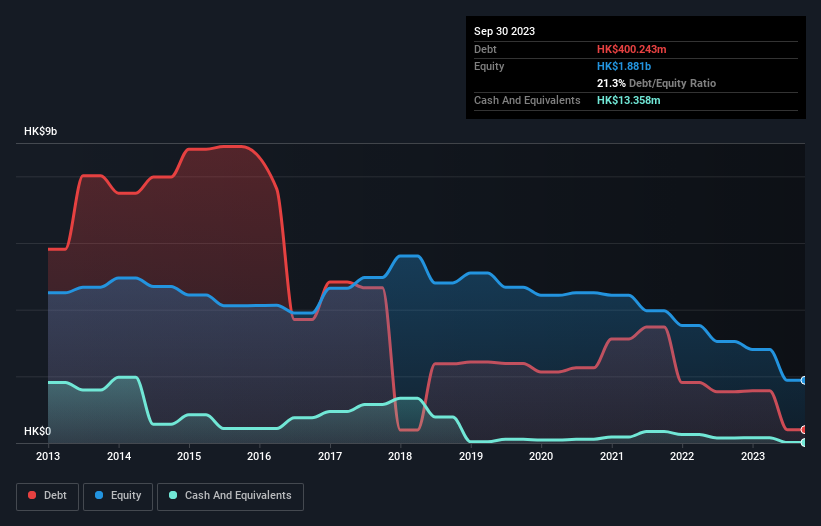- Hong Kong
- /
- Real Estate
- /
- SEHK:1124
Health Check: How Prudently Does Coastal Greenland (HKG:1124) Use Debt?
Howard Marks put it nicely when he said that, rather than worrying about share price volatility, 'The possibility of permanent loss is the risk I worry about... and every practical investor I know worries about.' So it seems the smart money knows that debt - which is usually involved in bankruptcies - is a very important factor, when you assess how risky a company is. Importantly, Coastal Greenland Limited (HKG:1124) does carry debt. But the real question is whether this debt is making the company risky.
What Risk Does Debt Bring?
Debt is a tool to help businesses grow, but if a business is incapable of paying off its lenders, then it exists at their mercy. If things get really bad, the lenders can take control of the business. While that is not too common, we often do see indebted companies permanently diluting shareholders because lenders force them to raise capital at a distressed price. By replacing dilution, though, debt can be an extremely good tool for businesses that need capital to invest in growth at high rates of return. The first step when considering a company's debt levels is to consider its cash and debt together.
See our latest analysis for Coastal Greenland
What Is Coastal Greenland's Debt?
You can click the graphic below for the historical numbers, but it shows that Coastal Greenland had HK$400.2m of debt in September 2023, down from HK$1.54b, one year before. On the flip side, it has HK$13.4m in cash leading to net debt of about HK$386.9m.

How Healthy Is Coastal Greenland's Balance Sheet?
According to the last reported balance sheet, Coastal Greenland had liabilities of HK$3.87b due within 12 months, and liabilities of HK$50.4m due beyond 12 months. Offsetting this, it had HK$13.4m in cash and HK$749.1m in receivables that were due within 12 months. So its liabilities total HK$3.16b more than the combination of its cash and short-term receivables.
This deficit casts a shadow over the HK$78.8m company, like a colossus towering over mere mortals. So we definitely think shareholders need to watch this one closely. At the end of the day, Coastal Greenland would probably need a major re-capitalization if its creditors were to demand repayment. There's no doubt that we learn most about debt from the balance sheet. But you can't view debt in total isolation; since Coastal Greenland will need earnings to service that debt. So when considering debt, it's definitely worth looking at the earnings trend. Click here for an interactive snapshot.
Over 12 months, Coastal Greenland reported revenue of HK$211m, which is a gain of 3,603%, although it did not report any earnings before interest and tax. That's virtually the hole-in-one of revenue growth!
Caveat Emptor
While we can certainly appreciate Coastal Greenland's revenue growth, its earnings before interest and tax (EBIT) loss is not ideal. Indeed, it lost a very considerable HK$148m at the EBIT level. When you combine this with the very significant balance sheet liabilities mentioned above, we are so wary of it that we are basically at a loss for the right words. Sure, the company might have a nice story about how they are going on to a brighter future. But the reality is that it is low on liquid assets relative to liabilities, and it lost HK$1.2b in the last year. So we think buying this stock is risky. When analysing debt levels, the balance sheet is the obvious place to start. However, not all investment risk resides within the balance sheet - far from it. For example Coastal Greenland has 3 warning signs (and 2 which shouldn't be ignored) we think you should know about.
If you're interested in investing in businesses that can grow profits without the burden of debt, then check out this free list of growing businesses that have net cash on the balance sheet.
New: AI Stock Screener & Alerts
Our new AI Stock Screener scans the market every day to uncover opportunities.
• Dividend Powerhouses (3%+ Yield)
• Undervalued Small Caps with Insider Buying
• High growth Tech and AI Companies
Or build your own from over 50 metrics.
Have feedback on this article? Concerned about the content? Get in touch with us directly. Alternatively, email editorial-team (at) simplywallst.com.
This article by Simply Wall St is general in nature. We provide commentary based on historical data and analyst forecasts only using an unbiased methodology and our articles are not intended to be financial advice. It does not constitute a recommendation to buy or sell any stock, and does not take account of your objectives, or your financial situation. We aim to bring you long-term focused analysis driven by fundamental data. Note that our analysis may not factor in the latest price-sensitive company announcements or qualitative material. Simply Wall St has no position in any stocks mentioned.
About SEHK:1124
Coastal Greenland
An investment holding company, invests, develops, and sells properties in the People’s Republic of China and Hong Kong.
Slight risk with imperfect balance sheet.
Market Insights
Community Narratives




